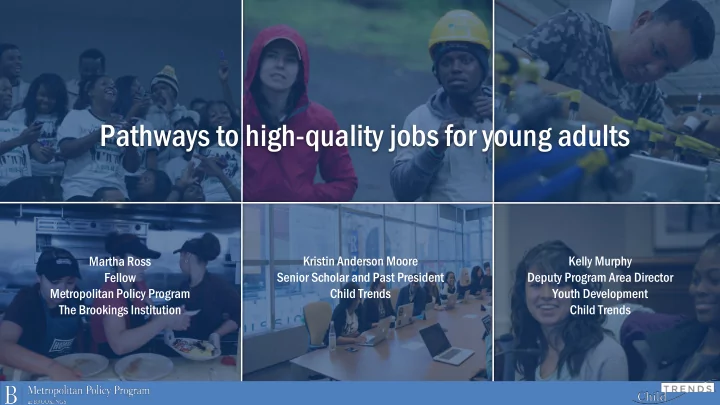

Pathways to high-quality jobs for young adults Martha Ross Kristin Anderson Moore Kelly Murphy Fellow Senior Scholar and Past President Deputy Program Area Director Metropolitan Policy Program Child Trends Youth Development The Brookings Institution Child Trends
Agenda Research question Data source Defining our measures Job quality Disadvantaged backgrounds Analytic strategy Findings Implications & recommendations
Research question
Research question How do young people find their way to high- quality jobs in adulthood? • Specifically, adolescents who are less likely to enroll in and complete a college degree immediately after high school For these young people, are there • particular education, training, and employment experiences in their teens and early- to mid-20s that make a difference?
Data source
Data source: The National Longitudinal Survey of Youth, 1997 Nationally representative survey of people born between 1980 and 1984 Its first round of questions began in 1997, when respondents were between the ages of 12 and 18 17 rounds of questions have been fielded in all, and respondents are now in their early to mid-thirties
Defining our measures
Defining the job quality index
Distribution of job quality scores Distribution of job quality scores from 0 to 8 0 1 2 3 4 5 6 7 8 2% 4% 8% 9% 17% 21% 20% 13% 4% Source: Child Trends analysis of NLSY97 data
Defining the sample using the National Longitudinal Survey of Youth 1997
Most 29-year-olds are employed, but background matters 90% 79% 79% of 29-year-olds from disadvantaged backgrounds are employed Disadvantaged Not disadvantaged Source: Child Trends analysis of NLSY97 data
29-year-olds from disadvantaged backgrounds are less likely to hold high-quality jobs 48% 38% 38% of 29-year-olds from disadvantaged backgrounds are employed in high quality jobs Disadvantaged Not disadvantaged Source: Child Trends analysis of NLSY97 data
Analytic strategy
Key variables of interest
Career and technical education Relationship-based CTE programs Other CTE programs Career majors Cooperative education Job shadowing Internships/apprenticeships School-sponsored enterprise Mentoring Tech prep
Findings
Predictors of job quality Positive predictors of job quality Negative predictors of job quality History of incarceration Age at first interview and cognitive test scores High school diplomas and post-secondary degrees earned Unemployment spells in one’s 20s by age 27 Being female Teen employment between ages 16 and 18 Relationship-based CTE in high school Higher earnings at age 23 Completing a training program between ages 24 and 27 Being married or cohabiting at age 27 Being Hispanic
Recommendations
Recommendations Strengthen work-based learning elements of high school career and technical education Internships, apprenticeships, cooperative education, and mentorship Increase completion rates of post-secondary degrees Advising, financial aid, guided pathways, dual enrollment (high school and college), bridge programs Strengthen on-ramps to employment Work-based learning and career exploration in high school, and, for older youth, programs that combine work readiness, skills training, academics, mentoring, supportive services, and paid internships or stipends Promote further research and action on the role of positive relationships in employment and training programs for youth and young adults
Pathways to high-quality jobs for young adults The Brookings Institution| Washington, DC| October 29, 2018 Photos courtesy of Andrew Burton, Chesapeake Bay Program, Institute for Apprenticeships via Flickr (license CC 2.0), Lucy Nicholson, Pexels, Reuters, Mike Segar, Joe Skipper, Shutterstock, University of Central Arkansas, U.S. Department of Agriculture, Yingchou Han via Unsplash, Jim Young
Recommend
More recommend